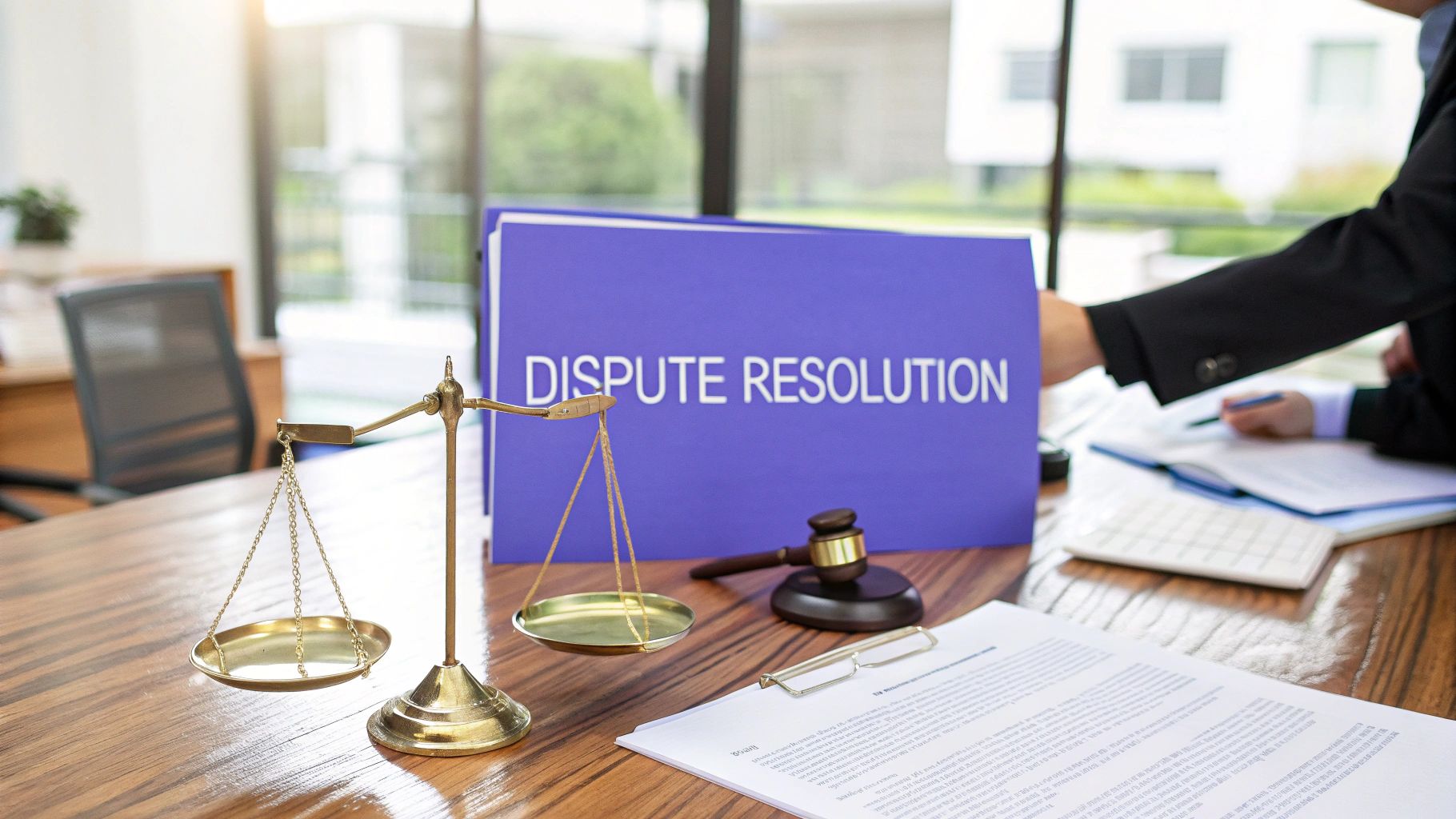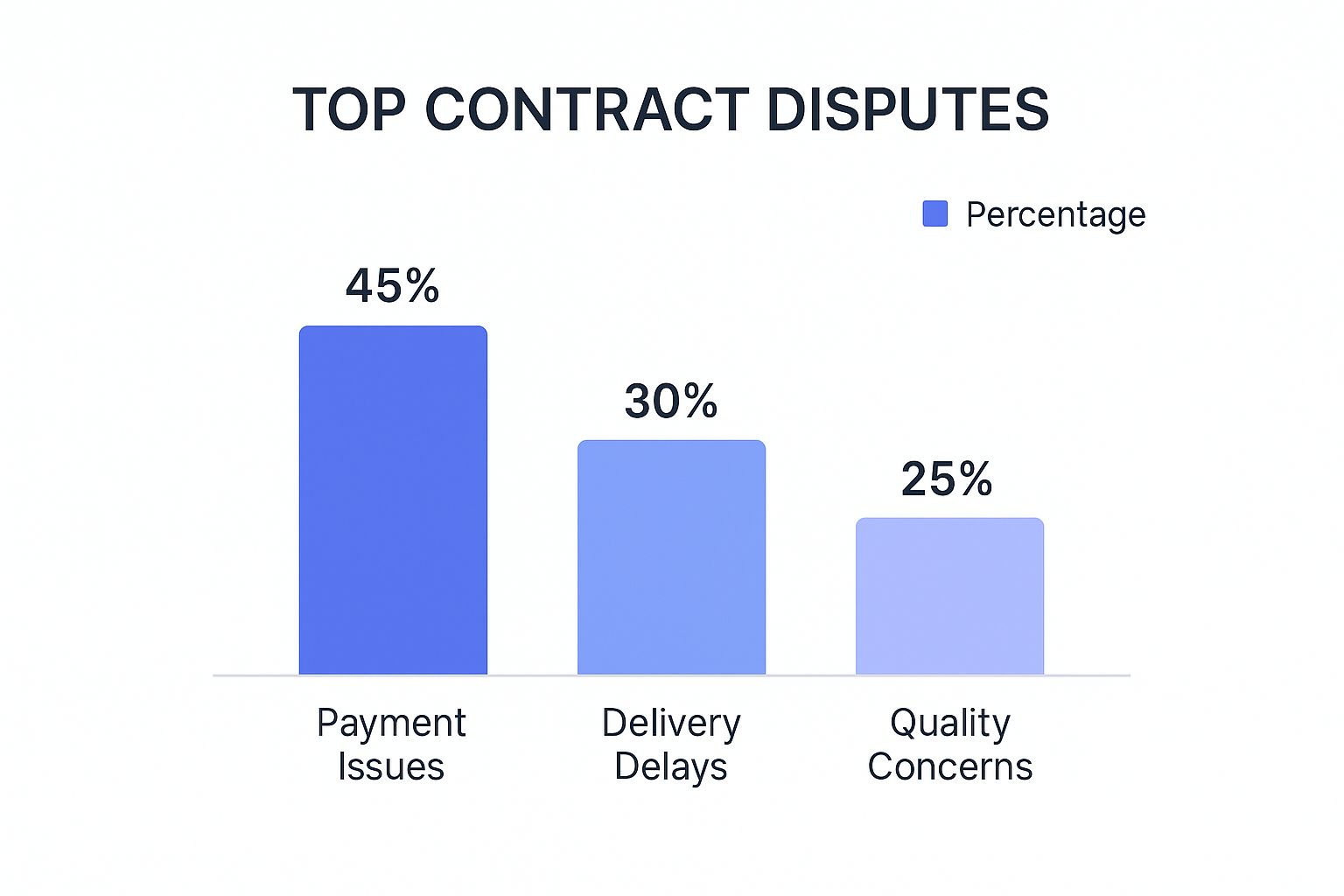
Understanding Contract Dispute Resolution Without the Legal Jargon

Think of contract dispute resolution as your business’s emergency toolkit. You hope you never have to use it, but when a disagreement pops up, having the right tools can be the difference between a quick fix and a complete catastrophe. It’s simply the game plan businesses follow to sort out conflicts over agreements.
This isn’t about immediately calling lawyers and heading to court. It’s a way of finding common ground when what was promised and what was delivered don't match up. The main objective is to fix problems efficiently, save money, and, most importantly, protect business relationships that can easily be destroyed by a long, drawn-out fight.
Why a 'Fight It Out' Mindset Is Obsolete
The old-school approach of threatening legal action at the first sign of trouble is quickly becoming a thing of the past. Why? Because it’s a terrible use of resources. A "fight it out" mentality drains your bank account, your time, and your energy—all things better spent on growing your business. Just one badly managed dispute can stop projects, ruin partnerships, and harm your company's reputation.
This reactive approach leaves your business exposed. Without a plan for how to handle disagreements, small issues can spiral out of control. Emotions often get in the way, communication stops, and the original problem gets buried under finger-pointing. A proactive strategy, on the other hand, gives you a clear map for lowering the temperature and focusing on solutions, not blame.
The Real Goal: Preserving Partnerships While Protecting Interests
A successful resolution doesn't mean one side has to "win." More often, it's about reaching a practical outcome that lets both parties get back to business. Imagine a supplier misses a crucial deadline. A lawsuit might get you some money back a year later, but it also burns that bridge forever. A structured negotiation could lead to a new schedule and a discount, saving a key relationship for future projects.
This focus on cooperative problem-solving is becoming the norm. The 2025 Global Disputes Forecast found that 41% of businesses now see putting dispute resolution clauses in their contracts as a top risk management tactic. They are building pathways to resolution from the very beginning. You can explore the full findings on managing global disputes.
Putting this into action means you need to know what your contracts actually say. Unfortunately, these important clauses are often buried in dense legal text. Before you can create a resolution plan, you first have to cut through the complicated language. Our guide to understanding common legal jargon is a great place to start. A clear plan protects your interests and keeps your business relationships healthy.
The Four Paths to Resolution: Choosing Your Best Route Forward
When a contract agreement hits a snag, many people assume a long, expensive court battle is the only option. In reality, that’s just one of several routes you can take. Think of contract dispute resolution as a roadmap with four different paths to a final agreement. Each route varies in speed, cost, and the type of journey you'll have. The right choice depends on the specifics of your disagreement, your budget, and whether you want to salvage the business relationship.
To pick the best path, it helps to know what causes most disputes in the first place.

This data shows that nearly 50% of contract disputes come from payment disagreements, which underscores the need for a thoughtful resolution strategy when financial friction arises.
Direct Negotiation: The First and Fastest Stop
Negotiation is the most direct path. It's a simple conversation between the parties involved to work out a solution together, without anyone else in the room. This isn't about winning an argument; it’s about collaborative problem-solving.
This method gives you complete control over the final decision and is easily the cheapest and quickest option. Because the talks are private, it’s also the best way to preserve a good working relationship. It is the perfect starting point for small misunderstandings or when both sides are motivated to find a quick, friendly solution.
Guided Mediation: Bringing in a Neutral Referee
When you can’t resolve the issue through direct talks, mediation is the next logical step. In this process, a neutral third party, called a mediator, joins the discussion. A mediator doesn't pick sides or make a decision. Instead, they act as a skilled facilitator, helping to clear up miscommunications and guide both parties toward their own agreement.
The entire process is confidential and non-binding, which means you’re not locked into any outcome unless you both agree to it. This lets you keep control while adding a structured format that can help break a stalemate. Mediation is a great tool for rebuilding trust when communication has broken down, but you both still want to avoid a formal legal fight.
To help you decide which path is right for your situation, here's a look at how the four main resolution methods stack up against each other.
Contract Dispute Resolution Methods Comparison
A comprehensive comparison of the four main dispute resolution methods showing time, cost, control, and privacy factors
| Method | Typical Duration | Cost Level | Decision Control | Privacy Level | Best Used For |
|---|---|---|---|---|---|
| Negotiation | Days to Weeks | Very Low | Full Control | High | Minor issues and preserving business relationships. |
| Mediation | Weeks to Months | Low to Moderate | High Control | High | Communication breakdowns where a cooperative solution is still desired. |
| Arbitration | Months | Moderate to High | No Control | High | Needing a final, binding decision without a public court case. |
| Litigation | Months to Years | Very High | No Control | Low | Complex legal points or when one party is completely uncooperative. |
As the table shows, the first two methods, negotiation and mediation, offer the most control and privacy at the lowest cost. The final two, arbitration and litigation, are more formal and place the decision in someone else's hands.
Binding Arbitration: A Private Courtroom
If a cooperative agreement is no longer possible, arbitration provides a more formal, yet still private, alternative to going to court. Imagine it as a streamlined, private trial. You and the other party select an impartial arbitrator (or a panel) to act as a private judge. After listening to both arguments, the arbitrator issues a decision, known as an "award," which is almost always legally binding and final.
This approach is generally faster and less costly than a public lawsuit, and its privacy keeps your company's sensitive details out of the public domain. For these reasons, many business contracts now include mandatory arbitration clauses. The main trade-off is that you give up control—the final word belongs to the arbitrator. This structured form of contract dispute resolution works best when you need a definitive outcome without the time, expense, and exposure of a court case.
Formal Litigation: The Last Resort
Litigation is the final and most intense path: taking your dispute to the public court system. This route involves lawsuits, judges, juries, and strict legal procedures. It is the most expensive, time-consuming, and public of all the resolution methods. Every document filed and argument made becomes part of the public record, and the hostile nature of the process usually destroys any chance of a future business relationship.
Due to its high costs and significant risks, litigation should always be treated as a last resort. It only becomes necessary when one side refuses to cooperate, a legal precedent needs to be established, or the dispute involves complex legal matters that only a judge can properly resolve.
Mastering Negotiation: Turning Adversaries Back Into Partners
 The best resolutions don’t always come from a judge’s ruling; they often happen around a simple conference table. Negotiation is the first and most direct path in contract dispute resolution, transforming a potential legal fight into a constructive conversation. It’s a process for guiding an adversary back to being a partner by choosing cooperation over conflict. This approach empowers you to solve problems directly, protecting your business relationships while keeping total control over the outcome.
The best resolutions don’t always come from a judge’s ruling; they often happen around a simple conference table. Negotiation is the first and most direct path in contract dispute resolution, transforming a potential legal fight into a constructive conversation. It’s a process for guiding an adversary back to being a partner by choosing cooperation over conflict. This approach empowers you to solve problems directly, protecting your business relationships while keeping total control over the outcome.
The Mindset Shift: From Winning to Problem-Solving
It's easy to walk into a negotiation thinking it’s a battle where only one side can win. This "zero-sum" approach, where one person’s gain is the other’s loss, almost always leads to a stalemate. Instead, successful negotiation begins with a mindset shift toward cooperative problem-solving. It starts by looking past positions (what each party claims they want) to uncover their interests (the real needs behind those wants).
Imagine two chefs are arguing over the last orange. Their shared position is, "I need that orange!" But if you dig deeper, you find their interests are different: one needs the juice for a sauce, and the other needs the peel for a dessert. The solution becomes obvious, and both get exactly what they need. Understanding this difference is how you find creative, win-win solutions.
A Framework for Successful Negotiation
While gut feelings can help, a structured plan is what keeps a discussion on track, especially when disagreements get heated. A solid framework gives you confidence and a clear process to follow, ensuring you remain focused on reaching a fair agreement.
- Prepare Thoroughly: Before any discussion, know your main goals, your absolute bottom line, and your Best Alternative to a Negotiated Agreement (BATNA). Your BATNA is your walk-away plan, and it's your most powerful tool.
- Listen Actively: Make an effort to truly understand the other side's point of view before presenting your own. This builds trust and often reveals common ground you might have missed.
- Separate People from the Problem: Frame the conflict as a shared challenge you need to solve together. By focusing on the issue instead of assigning blame, you lower defenses and make collaboration possible.
- Brainstorm Creative Options: Don't get stuck on the first idea that comes up. Work together to explore multiple possibilities that could address both of your core interests. This is where unexpected and highly effective solutions are often found.
Handling High Stakes and Difficult Dynamics
Of course, not every negotiation partner is reasonable. When you’re faced with a difficult personality, stay calm and rely on your prepared framework. Ground the conversation in objective facts, like industry standards or market rates, to steer it away from emotional arguments.
If there’s a power imbalance, your BATNA is more important than ever. Knowing you have a solid alternative gives you the confidence to stand firm on your essential points or walk away from a deal that doesn’t serve you. This strategic preparation is the key to achieving a fair result.
Ultimately, preserving the relationship while achieving your goals is the mark of a great negotiator. It ensures today’s dispute doesn’t destroy tomorrow’s opportunities, strengthening the foundation of your professional partnerships for the future.
Professional Mediation and Arbitration: When Neutral Help Actually Helps
When direct talks reach a dead end, it's easy to think a court battle is inevitable. But that’s not always the case. Bringing in a neutral third party can be the key to breaking the stalemate. This is where mediation and arbitration come in—two key methods of contract dispute resolution that offer a path forward without the high costs and public drama of a lawsuit.
The Mediator: A Guide to Common Ground
Imagine a mediator as a kind of relationship counselor for your business. Their goal isn't to declare a winner or loser. Instead, a mediator is a trained, impartial guide who helps both sides find a solution they can agree on. The process is completely voluntary and confidential, creating a safe space for honest conversation—which is essential if you want to save a valuable business partnership.
During mediation, the neutral party will typically:
- Start with a joint session where both parties can explain their perspectives without interruption.
- Hold private meetings (called caucuses) with each side to dig into their core needs and explore possible compromises.
- Help the parties think outside the box to find creative solutions that might not have surfaced during the original talks.
If an agreement is reached, it’s one that both parties have created together. This shared ownership means the solution is much more likely to be successful in the long run.
The Arbitrator: A Private Judge for a Final Decision
When you need a final, binding decision but want to avoid the courtroom, arbitration is the answer. Think of it as a private trial. Instead of a judge, both parties select a neutral arbitrator—often an expert in their field—to hear the evidence and make a ruling. This is particularly useful for technical disagreements where industry-specific knowledge is critical.
While more formal than mediation, arbitration is much faster and more flexible than going to court. Both sides present their case and evidence, but the procedures are less rigid. The arbitrator’s final ruling, known as an "award," is legally binding and carries the same weight as a court order. Because awards are very hard to appeal, arbitration delivers a clear and final resolution, letting everyone move on.
The Growing Preference for Neutral Intervention
More and more businesses are choosing to skip the traditional courtroom. This move toward alternative dispute resolution (ADR) isn't just a feeling; it's backed by data. For example, JAMS, a major global ADR provider, managed 21,390 new cases in 2024, a 10% jump from the previous year. This shows a clear trend toward wanting faster, expert-driven solutions. You can see more insights on this global ADR growth.
Preparing for a Successful Outcome
Your success in mediation or arbitration depends heavily on how well you prepare. The first step is choosing the right neutral expert. If you have a software development conflict, you’ll want an arbitrator who understands technology. For a dissolving partnership, you'd want a mediator with strong skills in managing group dynamics.
Preparation also means having your facts, documents, and goals in order. You must have a solid grasp of your contract's terms and obligations. This is where a tool like the Legal Document Simplifier can be a huge help. It can quickly break down a complicated agreement and identify the specific clauses causing the disagreement. Coming to the table well-prepared shows you're serious and helps set you up for a better result.
Strategic Litigation: When Court Becomes Your Best Option
 Negotiation, mediation, and arbitration are all designed to resolve disputes outside of a courtroom. But what happens when those paths are closed? Sometimes, heading to court is the only option left. It’s important to see litigation not as a failure, but as a calculated business decision.
Negotiation, mediation, and arbitration are all designed to resolve disputes outside of a courtroom. But what happens when those paths are closed? Sometimes, heading to court is the only option left. It’s important to see litigation not as a failure, but as a calculated business decision.
Think of it as the most decisive tool in your contract dispute resolution arsenal, used only when all other efforts to find a fair solution have been exhausted. This path requires careful planning and a clear understanding of what’s to come.
Recognizing the Tipping Point for Court Action
So, how do you know when it’s time to file a lawsuit? Litigation becomes the right move when other options have failed or just won't work for your situation. It's often the only choice when:
- The other party won't cooperate: They refuse to negotiate, ignore requests for mediation, or are clearly acting in bad faith.
- You need to set a legal precedent: Your case is about protecting intellectual property or securing a right that will affect your business down the line.
- You need an immediate court order: An injunction is necessary to prevent someone from causing serious damage, like leaking trade secrets.
- The issue is a complex legal question: The entire dispute comes down to a point of law that only a judge has the authority to decide.
Preparing for the Battle: Building a Strong Case
Choosing to litigate is only the beginning. A successful outcome depends on careful preparation that starts long before you ever step into a courtroom. Your legal team will steer the strategy, but the strength of your case hinges on the evidence you bring to the table.
Your job is to gather and organize every piece of relevant information. This includes the original contract, any changes or addendums, all related emails, and any other correspondence. Creating a detailed timeline is also vital to building a clear story of what happened.
The best defense is often a good offense. Performing a thorough contract risk assessment before a problem even starts can help you identify the specific clauses at the center of the disagreement. You can learn more in our article about contract risk assessment and how to spot trouble early.
The Realities of the Litigation Process
Going to court requires a realistic perspective on the process. The path can be long, costly, and emotionally draining. The discovery phase, for example, is where both sides must share all relevant information. This process can feel intrusive and often drags on for months, demanding significant time from you and your team.
The costs aren't just legal fees. You also have to factor in lost productivity and the potential for public proceedings to affect your reputation. The legal environment is also changing, with a sharp increase in class-action lawsuits. For instance, 133 class actions were filed in 2023 in Europe alone, adding a new dimension of risk for companies operating there. You can discover more insights on global litigation trends here.
The choice to settle or proceed to trial is a continuous balancing act of risk versus potential reward. Litigation is a powerful instrument for protecting your rights, but its success depends on solid preparation and a clear understanding of the commitment involved. It's a tool that should be used carefully, only when the potential outcome is worth the investment of time, resources, and energy.
Real Success Stories: How Smart Companies Resolve Disputes
Knowing the theory of contract dispute resolution is useful, but seeing how it works in practice is where the real learning happens. When we examine how actual businesses handle these conflicts, abstract ideas transform into effective strategies. These stories reveal practical lessons and patterns that not only solve problems but can also turn a potential crisis into an opportunity for growth.
From Software Bugs to Supply Chain Breakdowns
Imagine a software company that hired an external team to build a key part of its new platform. The project hit a wall when the code arrived full of bugs and past the deadline. The contract’s language on quality was vague, and a courtroom battle seemed like a costly, relationship-ending path. Instead, the company’s leaders suggested mediation.
By bringing in a neutral third party, both sides could air their frustrations constructively. They discovered the development team had been working with an outdated specifications document. This insight led to a collaborative solution: a revised development timeline and a plan to share the costs of the rework. The project was revived, and the business relationship was preserved, all without the expense and damage of a lawsuit. This shows how mediation can address the root of a problem, not just the symptoms.
In another scenario, a furniture maker received a large shipment of wood with minor defects that would become major issues after finishing. Simply rejecting the delivery would shut down their production line for weeks. Rather than launching a formal dispute, the procurement manager prepared for a serious negotiation. They documented the flaws with photos, calculated the exact financial impact of using the material (more labor, higher waste), and researched other suppliers to establish a strong Best Alternative to a Negotiated Agreement (BATNA).
Armed with this information, they didn't just reject the shipment; they negotiated a 30% discount and secured a commitment for higher-quality materials on all future orders. This approach turned a significant problem into a stronger, more reliable supplier agreement.
A Look at Industry Success Rates
The most effective resolution method often depends on the business sector. Different industries face distinct types of conflicts and have varying preferences for how to solve them. To see how these methods perform in different contexts, let's look at the data. The following table breaks down success rates and typical costs across several key industries.
| Industry | Negotiation Success % | Mediation Success % | Arbitration Success % | Average Resolution Time | Typical Cost Range |
|---|---|---|---|---|---|
| Technology | 75% | 85% | 60% | 2-4 Months | Low to Moderate |
| Construction | 50% | 70% | 80% | 6-12 Months | Moderate to High |
| Retail & E-commerce | 90% | 65% | 40% | 1-2 Months | Very Low to Low |
| Healthcare | 60% | 80% | 75% | 4-8 Months | Moderate |
As the numbers show, negotiation is highly effective and fast in retail, where supplier relationships are key. In contrast, the complex, high-stakes nature of construction projects often makes the formal structure of arbitration a more successful choice.
These stories and statistics reveal a powerful insight: successful contract dispute resolution is not accidental. It comes from making a deliberate, strategic choice. The software company prioritized its partnership, while the furniture maker used its leverage to achieve a better financial result. Both avoided the massive costs and delays of litigation by understanding their options, preparing meticulously, and executing a plan with a clear goal.
Your Complete Action Plan for Contract Dispute Resolution Success
Knowing what to do is one thing; turning that knowledge into a solid strategy is another. A win in contract dispute resolution isn't about luck. It’s about having a clear, proactive plan that protects your interests and preserves business relationships, long before a disagreement even starts. Here’s how you build that plan.
Building Your Proactive Defense
The best way to handle disputes is to stop them from happening in the first place. This begins with building internal processes that act as an early warning system. For example, setting up automated reminders for key contract deadlines or payment dates can prevent small oversights from becoming major problems. A key part of this defense is strong contract compliance management, which ensures everyone holds up their end of the bargain.
Think of your contracts as your first line of defense. They need to be built with clear, unambiguous language that spells out performance standards and exactly what to do if things go wrong. Explicitly state which resolution method—negotiation, mediation, or arbitration—to try first. This foresight provides a pre-approved script for handling conflicts, preventing a minor issue from escalating into a full-blown battle. It also helps you budget for different scenarios, so you aren't caught off guard by unexpected costs.
A Practical Roadmap for When Disputes Arise
When a conflict becomes unavoidable, your action plan is your playbook. Instead of reacting emotionally, you can execute a clear-headed strategy. The first step is to assess the situation objectively.
Use this simple framework to get started:
- Pinpoint the Exact Problem: Is it a late payment, a quality issue with a deliverable, or a simple breakdown in communication?
- Collect Your Evidence: Gather the contract, all related emails, project updates, and any other records that tell the story.
- Define Your Best-Case Scenario: Know what a successful outcome looks like for you. Crucially, you also need to know your Best Alternative to a Negotiated Agreement (BATNA)—your walk-away point.
The method you choose to resolve the dispute depends on how much control you want to maintain over the final decision. This chart shows the spectrum of options available.
As the visual shows, methods like negotiation and mediation put you in the driver's seat. In contrast, arbitration and litigation hand the final decision over to a neutral third party. Be alert for warning signs like a complete refusal to communicate or evidence of bad faith. These are clear signals that it's time to move from a collaborative approach to a more formal one.
Ultimately, your success comes down to preparation. An action plan is only effective if you have a complete grasp of the documents at the center of the dispute. Before you can make a move, you need total clarity.
The Legal Document Simplifier provides that clarity in minutes. Upload your contracts to get plain-language summaries that highlight key obligations, risks, and deadlines. Stop guessing and start building your strategy on a solid foundation of facts. Take control of your contracts with Legal Document Simplifier today.